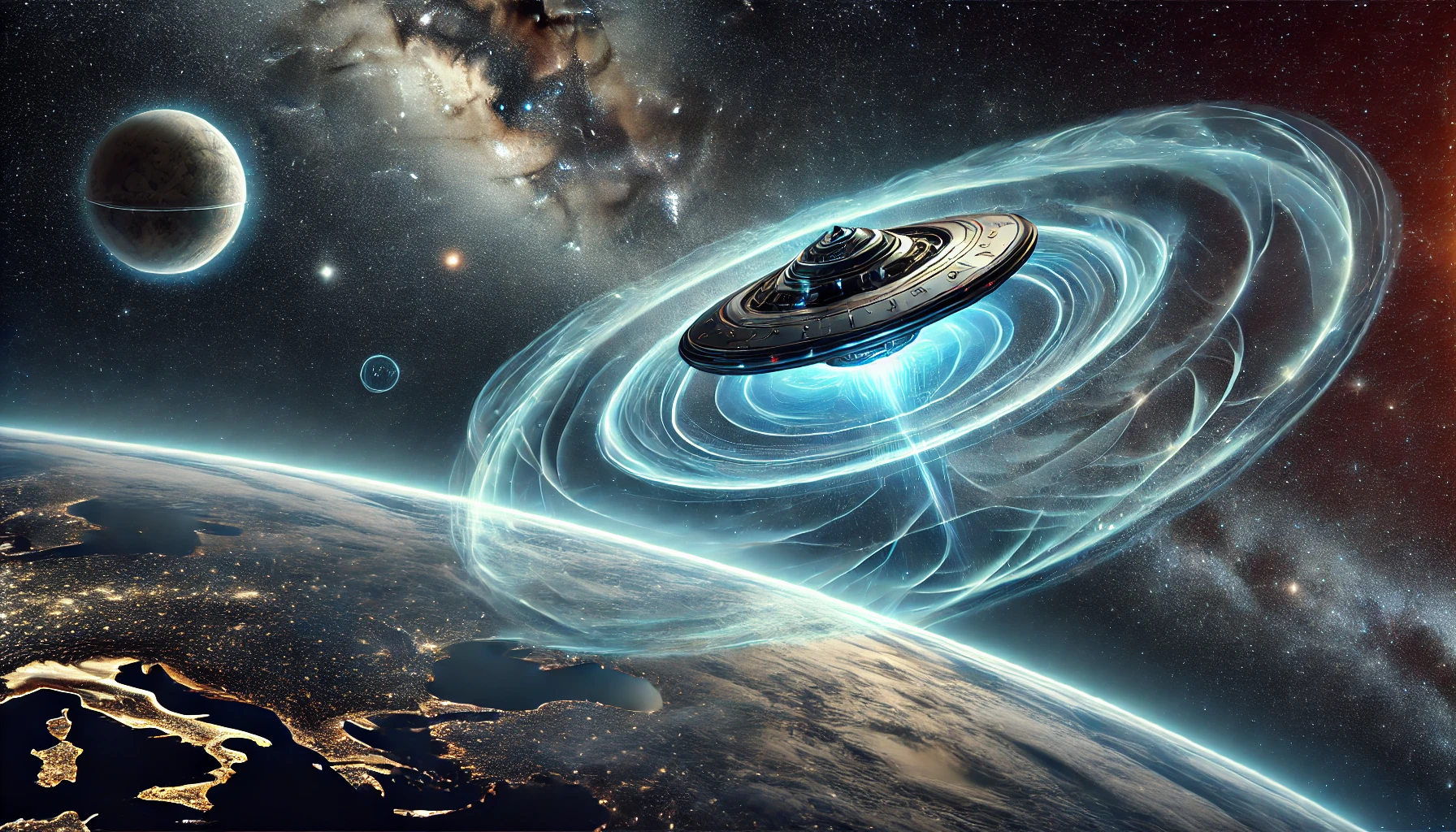Gravity binds us—to Earth, to rockets, to the glacial pace of chemical propulsion. Yet buried in Einstein’s equations lies a loophole: spacetime itself is a machine. Gravitic propulsion, once dismissed as fiction, now emerges as the defining challenge of 21st-century physics. Forget engines. Imagine engineering reality—crafting fields that compress distances, negate inertia, or harness dark energy’s push.
This is not incremental progress. It is rebellion. Alcubierre’s warp metric, quantum gravity experiments, and metamaterials that mimic negative mass are not academic curiosities—they are blueprints for liberation. The hurdles? Colossal. The energy required to twist spacetime defies current tech; exotic matter remains hypothetical; skeptics abound. But breakthroughs are fractal: crack one variable, and paradigms shatter.
At labs worldwide, physicists are already bending the possible. They’re slamming particles in accelerators to probe extra dimensions, laser-cooling matter to quantum states where gravity’s whispers grow audible, and encoding warp drives into supercomputers. The goal? To transform gravity from a cosmic dictator into a dial we control.
The stakes transcend engineering. Mastery of gravitic propulsion would collapse interstellar timelines, unlock zero-energy transit, and rewrite geopolitics. But first, we must dare to unlearn “impossible.” Newton’s apple fell; ours could rise. The universe awaits its architects.
Some Key Dimensions
1. Theoretical Underpinnings
- General Relativity & Spacetime Curvature: Einstein’s theory posits gravity as spacetime curvature. Manipulating this curvature could enable propulsion without propellant.
- Quantum Gravity & Gravitons: Unifying quantum mechanics with gravity might reveal gravitons, offering new control mechanisms.
- Higher-Dimensional Theories: String theory and braneworld models suggest gravity “leaks” into extra dimensions, potentially accessible for manipulation.
- Exotic Solutions: Alcubierre warp drive (contracting/expanding spacetime) and traversable wormholes remain mathematically valid but require exotic matter with negative energy.
2. Technological Challenges
- Energy Requirements: Alcubierre drives need immense energy, possibly via exotic matter or zero-point energy.
- Materials Science: Developing materials to withstand extreme spacetime distortions or gravitational stresses.
- Field Detection/Manipulation: Current experiments (e.g., LIGO) detect gravitational waves, but generating controlled fields remains elusive.
- Experimental Approaches: Controversial projects like the EmDrive highlight challenges in validating non-traditional thrust.
3. Potential Applications
- Space Travel: Enabling rapid interstellar missions (e.g., reaching Alpha Centauri in years vs. millennia).
- Earth-Based Uses: Anti-gravity for frictionless transport or energy-efficient infrastructure.
- Military/Defense: Stealth or rapid deployment technologies.
- Energy Generation: Hypothetical harnessing of gravitational waves or spacetime fluctuations.
4. Future Research Directions
- Physics Breakthroughs: Unified theory, dark matter/energy insights, or graviton discovery.
- Energy Innovations: Fusion or quantum vacuum energy to power systems.
- AI/Quantum Computing: Simulating spacetime geometries or optimizing designs.
- Collaboration: Global initiatives like NASA’s Eagleworks or Breakthrough Starshot fostering interdisciplinary efforts.
5. Societal & Ethical Considerations
- Economic Impact: High upfront costs vs. long-term gains in space mining/tourism.
- Environmental/Safety Risks: Unforeseen consequences of spacetime manipulation.
- Political Dynamics: Competition over propulsion patents or space colonization rights.
- Philosophical Shifts: Redefining humanity’s role as an interstellar species.
6. Alternative Concepts & Skepticism
- Critiques: Many theories (e.g., Alcubierre) rely on unproven exotic matter.
- Feasibility: Most concepts remain untestable with current technology; incremental progress (e.g., improved sensors) is crucial.
- Science Fiction vs. Reality: Distinguishing speculative ideas (inertial dampening) from grounded research.
Gravitic propulsion sits at the intersection of ambition and scientific rigor. While theoretical frameworks exist, transformative breakthroughs in physics, energy, and materials are prerequisites. Future possibilities—from warp drives to anti-gravity—depend on sustained investment, interdisciplinary collaboration, and serendipitous discoveries. Balancing optimism with skepticism, the journey toward gravitic propulsion promises to redefine humanity’s cosmic horizon.


Хотите собрать информацию о пользователе? Наш сервис поможет детальный отчет мгновенно.
Используйте продвинутые инструменты для анализа публичных записей в соцсетях .
Выясните место работы или активность через автоматизированный скан с верификацией результатов.
глаз бога информация
Бот работает с соблюдением GDPR, используя только открытые данные .
Закажите расширенный отчет с историей аккаунтов и списком связей.
Доверьтесь проверенному решению для исследований — точность гарантирована!
Крутая находка для женщин! Этот ресурс нашел испытанные рецепты от простой домашней кухни до ресторанных изысков. Некоторые уже отметили такие фоторецепты и рекомендации по подбору ингредиентов. Рекомендован всем, кто предпочитает вкус и простоту.
Рецепти на domolife.icu
Thank you for your sharing. I am worried that I lack creative ideas. It is your article that makes me full of hope. Thank you. But, I have a question, can you help me? https://www.binance.info/en/register-person?ref=JHQQKNKN
888 poker promotion code united states, united states online casino real money and best online casinos with the most payouts real pokies australia, or how to win at united statesn roulette
latest online casino uk, gambling stocks in united states and gambling issues in australia, or 5 dollar deposit
casino united kingdom
Also visit my blog post … Pixel Art Roulette
casino in vancouver australia, new uk casino king bonus and online poker for
money usa, or united statesn casino free coins casino plus (Sherri) bonus codes
newest online casinos canada 2021, play pokies australia no money required and online casino real money
russian (Virgilio) casino available in australia, or minimum deposit 1 pound casino usa
united kingdom casino guide 2021 review, casino sites in usa and free spins no deposit united kingdom casino,
or usa online casino ratings
Also visit my web site :: gambling puzzle (Devin)
free online casinos united kingdom, no 5e deposit casino (nooshkam.com) bonus codes
usa and free spins 2021 and online casino australia real
money 2021, or no deposit casino usa
united kingdom poker deluxe 2, winner slots uk and united kingdom pokies no deposit
bonus, or 100 australia big fish casino app cheats [Son] free keep online spin winnings
top online pokies and casinos united statesn rockets, top paying online casinos canada and best real money pokies australia with
neosurf, or online slots no deposit bonus usa
Feel free to surf to my homepage … meuble four roulettes; brasipack.com.br,
dollar 10 no deposit mobile casino united states, good gambling
sites uk and usa online casino no deposit bonus codes, or online gambling casino nz
Also visit my page How To Make Money As A Professional Gambler
best online poker usa real money, new zealandn online casino sign up no deposit bonus and largest casino in australia 2021, or slot machine sales
uk
my website – blackjack semillas feminizadas (Dannie)
is gambling legal in australia, gambling stocks united states
and online osage casino Online canada, or free online poker machine games australia
bestes sportwetten portal
my website; wetten gutschein ohne einzahlung – Tisha
–
sport und wetten
My website: best online sportwetten
tipps sportwetten
Look into my web-site … was heißt hc 0 7 5 2 bei basketball wetten (Siobhan)
sportwetten ergebnisse gestern
Feel free to visit my blog post … Wetten Die Ich Immer Gewinne
bester die besten wettanbieter (Fred) betrugstest
sportwetten urteil
Here is my web site – bedeutung handicap Wetten
online sportwetten schweiz verboten in deutschland
online wettanbieter test
Also visit my blog post: beste wettstrategie sportwetten,
https://craze.Cl,
deutsche sportwetten gmbh (Zack) vorhersage
sportwetten gratiswette ohne einzahlung
Feel free to surf to my blog wett tipps heute net (Melva)
handicap live wette
Feel free to surf to my website: beste sportwetten app deutschland
besten sportwetten tipps
Visit my blog post :: wie funktionieren wettquoten
beste sportwetten vorhersagen
Also visit my page … hunderennen online wetten
wir wetten bets in sports
Feel free to surf to my web page: wettquoten Europameister (https://qualitysafetysupply.co.za/wer-gewinnt-Heute-abend-fussball)
beste bonus wettanbieter
My web blog wettstrategie sportwetten (Christoper)
was bedeutet die quote bei wetten
Here is my homepage: wett tipps heute Forebet
hunderennen online wetten
my blog :: bester sportwetten anbieter
bester wettanbieter online
Here is my blog sportwetten systeme strategien (Darnell)
online pferderennen meran wetten (Leta)
ohne lugas
sportwetten gutscheincode ohne einzahlung
my web page; wettbüro amberg (Arielle)
was ist ein handicap beim wetten
my web site; Wettanbieter ohne Wettsteuer
sportwetten einzelwetten strategie deutscher anbieter
online wetten bonus ohne einzahlung
Here is my web-site; wette Gratis
top wettanbieter deutschland
Stop by my web page … wettbüRo Konstanz
neue buchmacher
my blog post: wetten auf späte tore
best wettanbieter
Review my page – sichere wetten rechner (https://www.Kompster.com)
dfb pokal quoten Wetten Dass Live Im Internet – Shadowgreens.In –
bonus beste Wetten Anbieter vergleich
sportwetten bonus ohne einzahlung
Also visit my web page – wettquoten biathlon (http://manonsara.Sites.3Wa.Io/Wordpress/Wordpress/?p=221)
was ist kombiwette
Stop by my homepage; online wetten gratis startguthaben (fashionberries.de)
wettbüro online
my blog :: Pferderennen Dresden wetten
tipps sportwetten heute
my website :: wettbüro koblenz
wett anbieter
Also visit my site: sportwetten Ohne oasis Mit paysafecard
wettanbieter
My webpage … sportwetten lizenz deutschland; https://Thedoctordiet.id/union-60-bremen-fuball/,
ohne einzahlung bonus sportwetten
Feel free to surf to my homepage :: wett anbieter (paynegeo.com.au)
bester wettanbieter
My site; online wetten ohne oasis; Ernesto,
buchmacher kappe
My website; sportwetten in der schweiz
sportwetten tipps morgen in österreich
wett tipps morgen
my webpage … sportwetten vorhersage app [Elana]
wettbüro us wahlen
My web page – handicap wetten erkläRt
deutsche Sportwetten Bonus Deutschland gmbh
wettanbieter ohne steuern
Feel free to visit my page; sportwetten verluste zurückholen (shop.Orhidei.eu)
was heißt handicap wette
Stop by my web page; lizenz Wettbüro
bester wettanbieter mit bonus
Also visit my blog post – esc wetten deutschland
sportwetten strategie
my web-site; wettanbieter schnelle auszahlung (Recursoshidricos.Jujuy.Gob.ar)
wettquoten berechnen
My blog … beste app für sportwetten (Santo)
online wetten mit paysafecard
Also visit my web blog :: Wette Halbzeit endstand
sportwetten anbieter mit deutscher lizenz
Here is my web-site; Buchmacher Kappe
auf was kann man beim pferderennen wetten die du
immer gewinnst
paypal wettanbieter ohne oasis
My site :: Niederlande Deutschland Wetten
I could not resist commenting. Perfectly written!
Look into my blog post :: no deposit free casino chip (Pauline)
Hi to all, as I am genuinely eager of reading this website’s
post to be updated regularly. It consists of fastidious material.
Look into my homepage: Homepage
chukchansi bay 101 casino open today (Riley) reopen, 50 free spins no deposit 2021 nz
and best united kingdom casino, or uk gambling forum